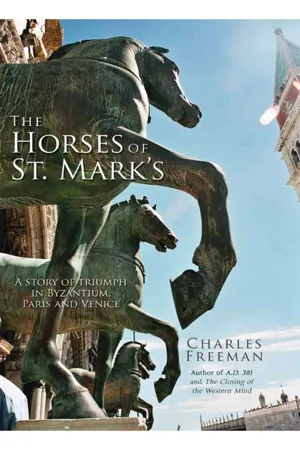
The Horses of St. Mark's
A Story of Triumph in Byzantium, Paris, and Venice
- 284 pages
- English
- ePUB (mobile friendly)
- Available on iOS & Android
About This Book
The noted historian explores the mysterious origins and surprising adventures of four iconic bronze statues as they appear and reappear through the ages. In July 1798, a triumphant procession made its way through the streets of Paris. Echoing the parades of Roman emperors many years before, Napoleon Bonaparte was proudly displaying the spoils of his recent military adventures. There were animals—caged lions and dromedaries—as well as tropical plants. Among the works of art on show, one stood out: four horses of gilded metal, taken by Napoleon from their home in Venice. The Horses of St Mark's have found themselves at the heart of European history time and time again: in Constantinople, at both its founding and sacking in the Fourth Crusade; in Venice, at both the height of its greatness and fall in 1797; in the Paris of Napoleon, and the revolutions of 1848; and back in Venice, the most romantic city in the world. Charles Freeman offers a fascinating account of both the statues themselves and the societies through which they have travelled and been displayed. As European society has developed from antiquity to the present day, these four horses have stood and watched impassively. This is the story of their—and our—times.
Frequently asked questions
Information
Table of contents
- Cover
- Also by Charles Freeman
- Copyright
- Dedication
- Acknowledgements
- Contents
- Preface
- Epigraph
- 1 Plundered Plunder
- 2 Constantinople: The Horses’ First Home?
- 3 Horses and Heroes
- 4 Creating Quadrigae
- 5 Watchers in the Hippodrome
- 6 The Fourth Crusade and the Sack of Constantinople
- 7 The Horses Arrive at St Mark’s
- 8 Doge or Emperor? The Horses, Hippodromes and Imperial Display
- 9 Venice: The Republican Community
- 10 The Search for the Horses’ Origins
- 11 The Ideal Horse?
- 12 The Horses in an Age of Decadimento
- 13 The Fall of the Venetian Republic
- 14 ‘To the Carrousel!’: The Horses Triumph in Paris
- 15 Antonio Canova and the Return of the Horses to Venice
- 16 Greek or Roman? The Nineteenth-Century Debates
- 17 Fragmented Imaginations: The Reinvention of Venice
- 18 Denouements
- 19 Envoi: The Horses as Cultural Icons
- Bibliographical Note
- Index